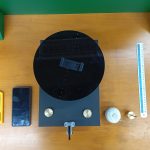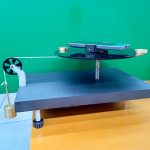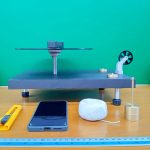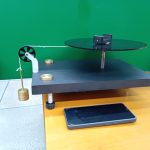| Student Manual | 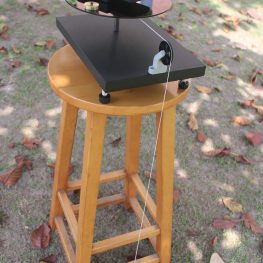 This experiment achieves three purposes. The first is the understanding of the dynamical equation of motion as an object rotates, bringing home the correspondence between force and torque, mass and moment of inertia and linear versus angular kinematics. Second, the smartphone has a gyroscope and an accelerometer offering a rich vistas for exploration in the physics laboratory. Third, once you get data, you would like to choose and make up your variables, identify the dependent and independent variables, separate them from the parameters and linearize graphs. All in one! |
| Software Code | https://phyphox.org/ |
| Sample Results | Angular velocity (just the z component) for first bounce of the hanging massAngular velocity—a time course for anyone positional setting of the massThe angular acceleration plotted as a function of distance squared |
| Hardware Manual | An exploded view of the hardwareTop view of the platter showing dimensions of placement of masses |
| Experiment Code | 1.35 and 5.7 |
| Version | 2024-v1 |
Further Readings and References
- Precise measurement of velocity dependent friction in rotational motionEuropean Journal of Physics, J. Alam, H. hassan, S. Shamim and W. Mahmood, 32, 1367, (2011).
- The circular Atwood machineThe Physics Teacher,https://arxiv.org/abs/2310.12122, A.C. Marti, M. Monteiro and C. Stari, 62, 150-151, (2024).
Pictorial Procedure
Here is a step-by-step pictorial guide as well.
- 1. Top view of the circular Atwood machine setup, displaying the central pulley, attached masses, phone holder, and tensioned string, illustrating the symmetrical arrangement crucial for the experiment.
- 2. Side view of the setup displaying the smaller vertical pulley for applying external torque.
- 3. A hanging mass securely attached to the string, ensuring the correct distribution of weight and tension for the circular Atwood machine’s operation.
- 4. Masses and a phone are placed on the rotating platter, with the phone serving as a sensor to record angular velocity and other data during the circular Atwood machine experiment.
- 5. Open phyphox app already installed in a smart phone.
- 6. From the Phyphox app’s main menu, select the Gyroscope icon to measure the rotational motion parameters of the circular Atwood machine.
- 7. Once the setup is ready to start rotation of the disc, click play icon to measure and record data and click the pause icon after rotation has been stopped.
- 8. Click the three dots at right corner on the Gyroscope to export data.
- 9. Click on the export data icon.
- 10. Click on the CSV to save data to save data in this format and extract it to the destination folder in order to transfer it to computer through email or data cable.
